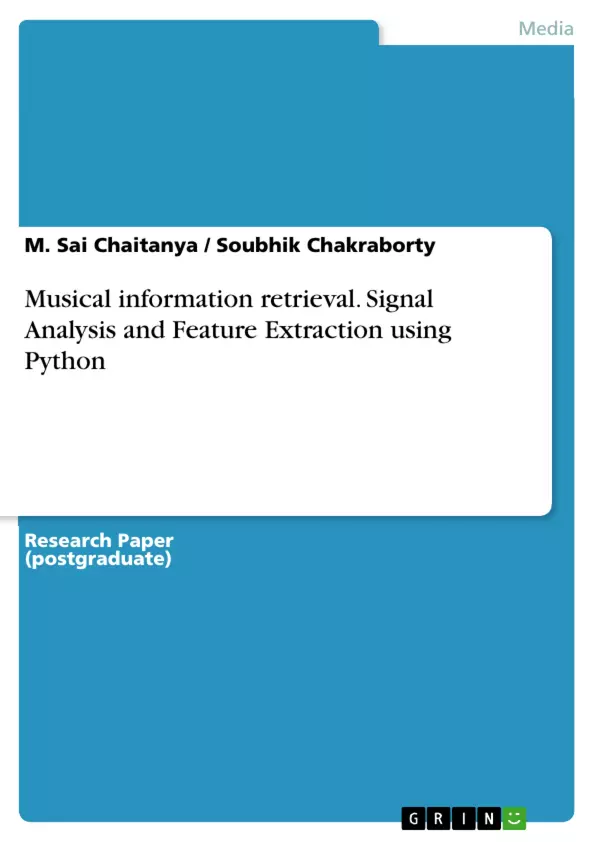This work gives a comprehensive overview of research on the multidisciplinary field of Music Information Retrieval (MIR).
MIR uses knowledge from areas as diverse as signal processing, machine learning, information and music theory. The Main Feature of this work is to explore how this knowledge can be used for the development of novel methodologies for browsing and retrieval on large music collections, a hot topic given recent advances in online music distribution and searching. Emphasis would be given to audio signal processing techniques.
Music information retrieval (MIR) is the interdisciplinary science of retrieving information from music. MIR is a small but growing field of research with many realworld applications. Those involved in MIR may have a background in musicology, sychoacoustics, psychology, academic music study, signal processing, informatics, machine learning, optical music recognition, computational intelligence or some combination of these.
MIR is being used by businesses and academics to categorize, manipulate and even create music. One of the classical MIR research topics is genre classification, which is categorizing music items into one of pre-defined genres such as classical, jazz, rock, etc. Mood classification, artist classification, and music tagging are also popular topics.
Inhaltsverzeichnis (Table of Contents)
- INTRODUCTION
- Chapter 1- Review of Music Concepts
- 1.1 Literature Overview
- 1.2 Basic music elements
- 1.3 Music terminology
- Chapter 2- Musical Information Retrieval
- 2.1 What is MIR?
- 2.2 Feature Extraction
- 2.2.1 Low-level similarity
- 2.2.2 Top-level similarity
- 2.2.3 Mid-level similarity
- 2.2.4 Process of Feature extraction
- Chapter 3- Signal Analysis and Feature Extraction using Python
- 3.1 Why Python?
- 3.2 Basic Feature Extraction
- 3.2.1 Zero Crossing Rate
- 3.2.2 Fourier transform using python
- 3.2.3 Short-Time Fourier Transform using python
- 3.2.4 Spectrogram
- 3.2.5 Mel-spectrogram
- CONCLUSION
Zielsetzung und Themenschwerpunkte (Objectives and Key Themes)
This paper provides a comprehensive overview of the interdisciplinary field of Music Information Retrieval (MIR), focusing on the utilization of knowledge from signal processing, machine learning, information theory, and music theory for developing novel methodologies for browsing and retrieval on large music collections. The paper emphasizes audio signal processing techniques and explores the practical applications of MIR in the context of online music distribution and searching.
- Exploration of MIR's role in music information retrieval and browsing.
- Examination of the intersection of music theory, signal processing, machine learning, and information theory in MIR.
- Development of novel methodologies for retrieving information from music collections.
- Emphasis on audio signal processing techniques within the MIR framework.
- Investigation of the impact of MIR on online music distribution and searching.
Zusammenfassung der Kapitel (Chapter Summaries)
- Chapter 1: This chapter introduces the basic concepts of music and provides a literature overview of the field. It defines key musical elements and terminology that are essential for understanding MIR.
- Chapter 2: This chapter delves into the core of MIR, defining what it entails and exploring the process of feature extraction. It examines different levels of similarity in music analysis, including low-level, top-level, and mid-level similarities.
- Chapter 3: This chapter focuses on the practical application of signal analysis and feature extraction using the Python programming language. It explains the rationale behind choosing Python and introduces fundamental feature extraction techniques like zero crossing rate, Fourier transform, Short-Time Fourier Transform, spectrogram, and Mel-spectrogram.
Schlüsselwörter (Keywords)
The primary keywords and focus topics of this paper include Music Information Retrieval (MIR), signal processing, machine learning, feature extraction, audio analysis, online music distribution, music browsing, and retrieval methodologies. It emphasizes the integration of these concepts to develop innovative solutions for navigating and understanding large music collections.
- Citar trabajo
- M. Sai Chaitanya (Autor), Dr. Soubhik Chakraborty (Autor), 2021, Musical information retrieval. Signal Analysis and Feature Extraction using Python, Múnich, GRIN Verlag, https://www.grin.com/document/1031816



